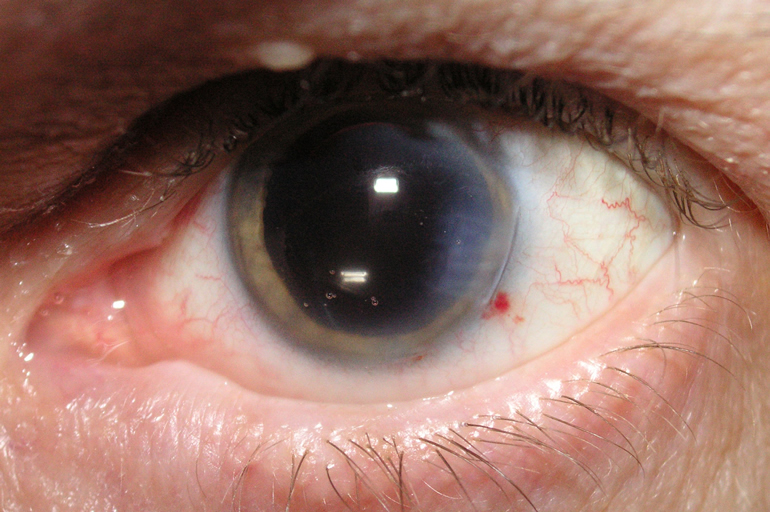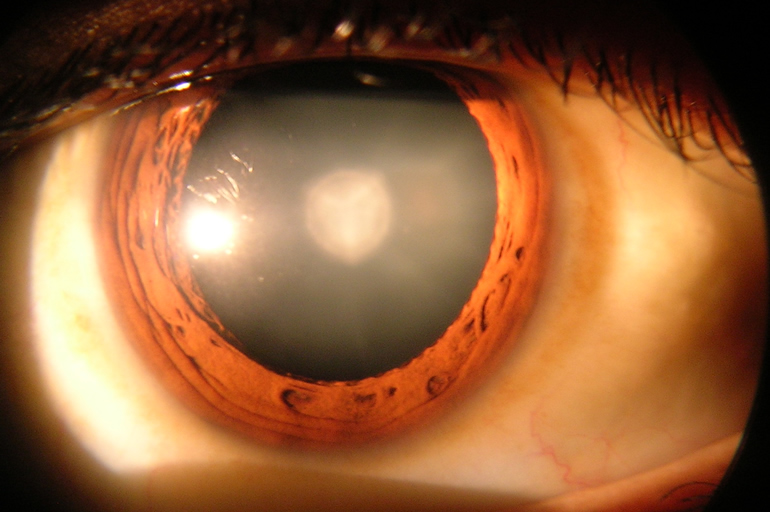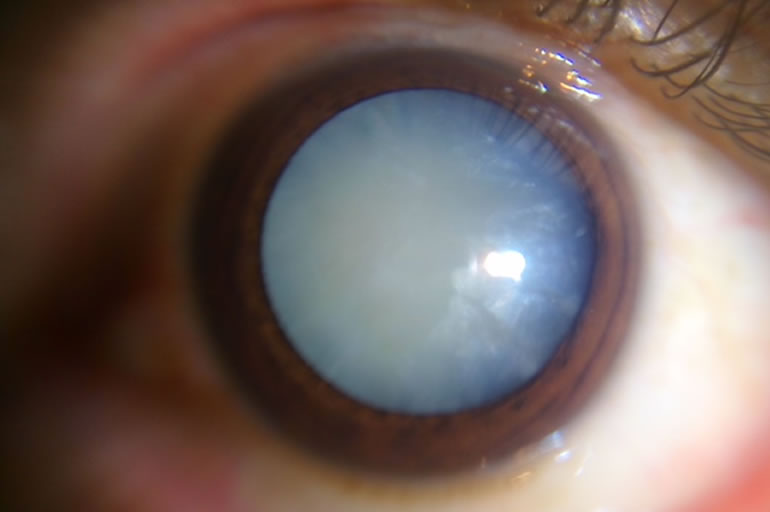Cataract Surgery & Refractive Lens Exchange including PRELEX
What is a cataract?
Within the eye there is a lens. This is normally transparent but when it becomes hazy, it is called a cataract. When the vision is affected to such an extent that normal daily activities are difficult or when the visual disturbance impacts on quality of life, then surgery should be considered. It is no longer necessary to wait for the cataract to become "ripe" (a term from the 1950s) or for all vision to be lost before undertaking cataract surgery. The earliest symptoms of cataract are sensitivity to light and glare from car headlamps as well as the feeling that your glasses are dirty and need cleaning even when they do not.




What can be done about cataracts?
Cataracts can only be removed by surgery. They cannot be treated by medicine or eyedrops. The cataract operation aims to improve your vision by removing the misty lens and replacing it with an intraocular lens (IOL). The IOL is an implant that does not require cleaning or indeed wear out and modern foldable IOLs enable the operation to be performed through a much smaller wound, meaning fewer restrictions for you after the operation. Most patients can resume normal activities the next day.
Cataract surgery is generally so successful that it has become the commonest operation performed in virtually all developed countries. However, many studies have shown that the very low complication rate is lowest when an experienced surgeon carries out the procedure.
What are the choices of implant / IOL?
The IOL can be one of two classes: monofocal or multifocal. Monofocal IOLs have a single focus which is usually targeted on good vision for distance without glasses, meaning spectacles for reading and near-vision tasks will be required. If you have significant astigmatism, then a special toric IOL will be needed.
Multifocal IOLs come in three versions: bifocal, trifocal and extended depth of vision (EDOF). These IOLs have the big advantage of reducing the need for spectacles and indeed many patients are spectacle-independent however with all multifocal lenses, there is a small reduction in visual quality. Although it needs to be discussed with you in detail, bifocal IOLs are good for reading and distance, but not so good for intermediate; trifocals are good at intermediate. Both these IOL classes work by producing "simultaneous vision" meaning that some patients are aware of a ghost image, especially at night. Almost all patients learn to ignore the ghost image over a 6 month period by a process called "neuro-adaptation". In contrast, the EDOF lenses are less likely to cause ghost images and are good for distance and intermediate, but perhaps not quite as good for near especially very small tasks such as sewing or reading a menu in poor lighting when spectacles are likely to be required. Recently, we have seen conventional multifocal and EDOF technology combined, a development predicted by Professor Claoué. However, there is no doubt that for most people who dislike spectacles, multifocal IOLs have a lot to offer.
What will happen before surgery?
Before your surgery, you will have an appointment with your surgeon to discuss your suitability for cataract surgery, the risks and benefits of the procedure and lens choice. At this appointment, your eye will be examined and measured. Measurements of the shape of your eye and the length of your eye will be taken to enable your surgeon to decide which power of lens to implant in your eye. It is important not to drive to this consultation as your pupils may need to be dilated. This typically blurs the vision for 4-6 hours.
What will happen during surgery?
Cataract surgery is most often performed as a day-case procedure under local anaesthetic meaning that you will be awake during the operation but you will not feel any discomfort. Patients can expect to be in hospital for just a few hours. You will have the opportunity to meet your surgeon again before the operation and he will also see you after the procedure. Before the surgery you will be given drops to dilate your pupil and some local anaesthetic drops to numb the eye. The eye and the area around the eye is then cleaned to help prevent infection. Your face will then be covered in a sterile sheet so that only the eye being operated on is exposed. The operation itself is relatively quick and takes about 10 to 15 minutes on average. During the surgery you may be able to see movement and changes in lights or shadows but you will not be aware of the actual surgery.
Recovering from cataract surgery?
After surgery, your vision may still be slightly blurry in the first few days - the eye will be inflamed and need time to settle before the full vision is returned. A change in glasses may be needed after the operation before the full benefits are realised. Old glasses may be worn after the operation if this helps the sight and they will not do the eye any harm. Sunglasses may be useful if lights are found to be very dazzling - do what keeps comfortable and allows you to see best. Drugs given as eye drops will be needed after the operation, usually for 4 weeks. These are important to minimise the risk of infection and to help the eye inflammation settle quickly - please use them regularly as instructed. In some cases they may need to be continued longer, but the consultant will provide instructions to this effect. At night, you may be given a plastic eye shield to wear which will prevent you from accidentally rubbing the eye during sleep.
The eye should not be painful after the operation - a scratchy feeling or a mild ache is quite usual and should settle with painkillers such as paracetamol. Should the eye become very painful, and especially if the vision from the eye worsens then you should contact the practice immediately.
There are very few restrictions required after this type of operation because the wound is so small. Please do not rub the eye as this will be painful and may do damage although this is highly unlikely. Try to avoid anything too strenuous for about a fortnight after the operation and avoid swimming whilst using the drops. Reading and television are not a problem and neither is bending but it is advisable to avoid strenuous activity for about a month. If you have a particular worry about a particular activity, please ask your consultant.
Spectacles after cataract surgery
The aim of cataract surgery is improve vision and also to reduce spectacle dependence. Your vision after surgery may still be a bit fuzzy until new glasses are prescribed if needed.
For monofocal lenses, the usual target is for good distance vision however it is likely that some form of glasses will be required for fine-tuning at distance and also for reading. For multifocal lenses, the aim is to reduce spectacle dependence for distance vision and a combination of intermediate (e.g. tablet use) and / or near vision. However some form of spectacle may still be required for fine-tuning.
What are the complications of cataract surgery?
Cataract surgery is a safe and successful operation. The chances of having a complication are very low. The risk of having complications that could affect your sight in the long term is even lower. Generally speaking, you have a 97% chance of your cataract operation being successful, meaning that you will have a good level of clear vision following the operation.
The most likely complication following the procedure is called posterior capsule opacification where the bag that held the cataract thickens in the first year to eighteen months following the surgery. This can be treated with a routine outpatient laser procedure to divide the thickened bag, at very low risk.
Other rarer complications of cataract surgery include: retinal detachment, macular oedema, infection, a break in the lens capsule and problems with lens implant positioning. If you do have any of these rare complications, you will be offered further treatment to help maintain good vision.
If you are concerned about the risks of cataract surgery then please discuss this with your surgeon before surgery. Most people who have cataract surgery have no problems at all.
Refractive Lens Exchange / PRELEX (PREsbyopic Lens EXchange)
A refractive lens exchange is essentially a cataract operation done for patients who dislike spectacles. In general, patients who are over 45 years of age may be suitable. The IOL implanted is usually targeted on good vision for distance without glasses, meaning spectacles for reading and near-vision tasks will be required unless a type of multifocal IOL is used.
PRELEX is a type of refractive lens exchange to treat presbyopia. It is well known that people who have enjoyed good vision for distance will require reading glasses sometime after the age of 45. This is due to presbyopia, which is a normal phenomenon. It is caused by a progressive loss of the ability of accommodate i.e. change the focus of the eye and is a normal developmental phenomenon. Whilst presbyopia has been treated with spectacles or special contact lenses, cataract surgery can be combined with a multifocal lens to reduce spectacle or contact lens dependence. This technique was first described by Professor Claoué at ESCRS in 1997 and has become the "gold standard" for lens-based presbyopia surgery. Now that toric multifocal IOLs are available, most eyes are suitable for this surgery. However, a consultation is essential to determine suitability and to make sure that your expectations are likely to be met.
